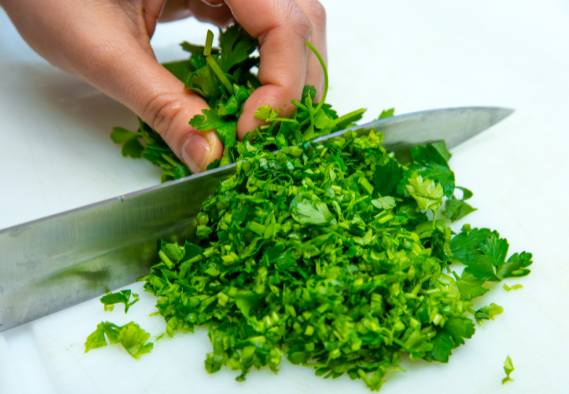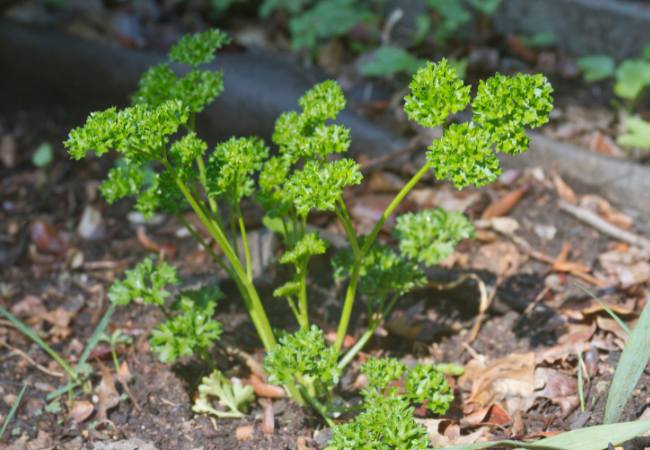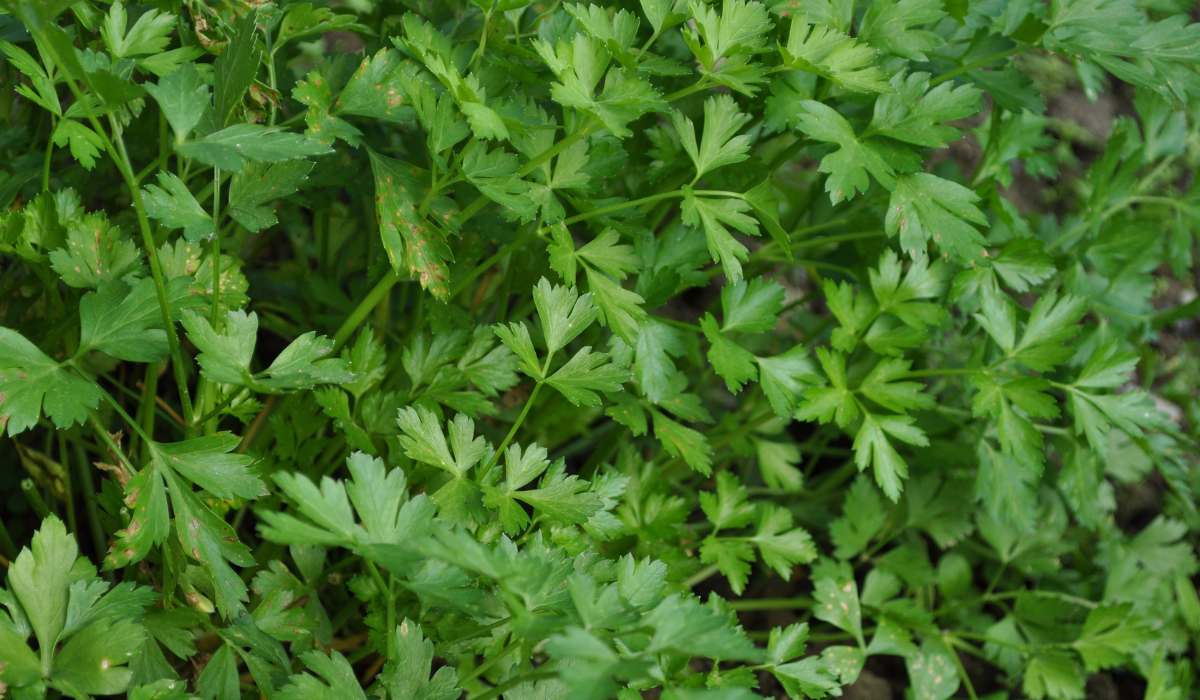Parsley: Health Benefits, Uses & Magical Properties
When it comes to parsley, its exceptionally high vitamin K content takes centre stage. Just 1 tablespoon of fresh parsley provides over 70% of your daily vitamin K needs—a nutrient crucial for bone health and blood clotting. This makes parsley more than just a garnish—it’s a tiny leaf with big benefits for your well-being.
Parsley is one of those herbs that has been around forever—full of history, health benefits, and even a bit of magic.
So, what’s the deal with parsley? I grow it in my garden and use it almost every day in the kitchen.
I think a salad without parsley is missing all the oomph it could contain!
But what’s amazing about this herb?
Whether you’re looking to add a pop of flavour to your meals, support your health naturally, or tap into its mystical energy, parsley has got you covered. It’s versatile, easy to use, and packs a powerful punch.
Keep scrolling to find out why parsley deserves a spot in your kitchen (and maybe even your wellness routine).

Latin Name
Parsley belongs to the Petroselinum crispum species, a member of the Apiaceae family.
Its botanical name hints at its traditional use and its Greek origins—petros means ‘stone’, as parsley often grows in rocky places.
This hardy herb is more than just a garnish—it’s packed with nutrients and health benefits that have made it a staple in kitchens and herbal medicine for centuries.
Rich in vitamins A, C, and K, as well as minerals like iron and calcium, parsley contributes to everything from bone health to immune support.
Plus, it’s loaded with antioxidants that help protect your body from damage.
Whether you’re using it to add freshness to a dish or to support your overall well-being, parsley has a lot to offer.
Interesting Facts About Parsley
| Fact | Benefit |
|---|---|
| 1 tablespoon of fresh parsley | Provides more than 70% of your daily vitamin K needs, supporting bone health. |
| Rich in chlorophyll | Helps freshen breath naturally—great for chewing after a meal! |
| Antioxidants like flavonoids | Protect your cells from damage, reducing oxidative stress. |
| Daily consumption | May help reduce water retention due to its natural diuretic effect. |
| High in vitamin C | Boosts immune function and helps maintain healthy skin. |

Taste/Fragrance
Parsley has a bright, fresh flavour that brings life to any dish. It’s slightly bitter, mildly peppery, and just the right amount of earthy, making it perfect for balancing out richer flavours.
Whether it’s a salad, a sauce, or a garnish, parsley is that final touch that makes everything taste just a bit better…
- Taste: Fresh, lively, and a bit peppery—it’s the herb that adds that ‘oomph’ to your cooking!
- Fragrance: Crush the leaves, and you’re met with a green, slightly spicy scent—like a garden after it rains, full of life and freshness.
🌿 Tip: Always add fresh parsley at the end, just before serving. It keeps the flavour vibrant and ensures you’re getting all those good nutrients. That’s how I’ve been doing it for years now. It makes a difference, you’ll see.
Parts Used
Parsley is a multi-talented herb, and every part of it has its own benefits—it’s not just about the leaves.
- Leaves: These are the ones everyone uses, whether fresh or dried (I prefer fresh!). They bring that burst of flavour and are loaded with health benefits. So, yes, always go for fresh if you want the most potency.
- Stems: Don’t overlook the stems! They pack a punch in terms of flavour, especially in stocks or stews. Just chop them up finely and toss them in. Easy.
- Root: Did you know parsley has a root that looks like a white carrot? It’s used in some cuisines and has its own unique set of nutritional perks.
🌿 Tip: When chopping parsley, include the stems for extra flavour—just leave out the tougher bottom bits. They can be a bit chewy in my opinion.
Main Constituents
Parsley packs a serious punch when it comes to nutrients.
It’s loaded with vitamins, minerals, and other powerful compounds that make it so much more than just a garnish.
- Volatile oils: Apiol and myristicin are what give parsley its distinct aroma, and they also help support detoxification. These oils are part of what makes parsley so unique.
- Flavonoids: Antioxidants like apigenin and luteolin help protect your body from damage caused by free radicals.
- Chlorophyll: This is what gives parsley its beautiful green hue. Beyond the colour, chlorophyll helps detoxify your body and keeps things running smoothly.
- Vitamins: Packed with vitamins A, C, and K, parsley helps boost immune function, supports healthy skin, and aids in blood clotting. Just a sprinkle goes a long way!
- Minerals: Parsley is rich in essential minerals like iron, calcium, and magnesium—all crucial for bone health and overall wellness.
The below table helps clarify some of the above in a very visual, easy way to understand and take the information in:
Vitamins, minerals, and key compounds in parsley
| Nutrient | Benefits | Amount (per 30g serving) |
| Vitamin A | Supports vision, immune function, and skin health. | 2818 IU (56% DV) |
| Vitamin C | Boosts the immune system, helps with collagen production, and supports skin health. | 30 mg (50% DV) |
| Vitamin K | Crucial for bone health and proper blood clotting. | 498 mcg (415% DV) |
| Iron | Helps in the formation of red blood cells and prevents anemia. | 1.9 mg (10% DV) |
| Calcium | Essential for maintaining strong bones and teeth. | 41 mg (4% DV) |
| Magnesium | Supports muscle and nerve function, as well as energy production. | 15 mg (4% DV) |
| Flavonoids (e.g., apigenin, luteolin) | Provide antioxidant benefits, protecting cells from oxidative stress. | Present in trace amounts |
| Chlorophyll | Aids in detoxifying the body and supports overall health. | Significant, contributes to green colour |
| Volatile oils (apiol, myristicin) | Contribute to detoxification and give parsley its unique aroma. | Present in trace amounts |
No wonder parsley has been a kitchen staple for centuries—it’s a nutritional heavyweight in a tiny, leafy package!

Actions/Properties
Parsley isn’t just for adding a pop of green to your plate—it comes with a range of health-boosting properties that make it a real asset in any natural health routine.
1. Digestive aid
Parsley can work wonders for your digestion. It helps stimulate digestive juices and reduces bloating, making it a great choice for a happy gut.
What does this really mean? Think of parsley as a gentle kickstarter for your digestive system. The compounds in parsley encourage your stomach to produce the juices needed to break down food efficiently. This means less gas, less discomfort, and a smoother digestion process overall.
2. Natural diuretic
Need a little help flushing out excess water? Parsley supports healthy kidney function by boosting urine production, helping to keep everything running smoothly.
Why does this matter? Our bodies can sometimes hold onto excess water, leading to that bloated feeling. Parsley’s natural diuretic effect helps your kidneys work more effectively, flushing out that extra water along with toxins, which helps you feel lighter and reduces swelling.
3. Anti-inflammatory
The compounds in parsley can help reduce inflammation—perfect for anyone dealing with joint pain or stiffness.
How does it help? Chronic inflammation can be a root cause of many health issues, especially when it comes to joints. Parsley contains antioxidants and anti-inflammatory compounds that help cool down that internal inflammation, providing some natural relief for achy joints.
4. Detoxifying
Parsley helps cleanse your liver and supports the body’s natural detox processes. It’s like a mini-detox in herb form!
But what does “detox” mean? Your liver is the body’s main detox organ, working hard to filter out toxins and waste. Parsley helps this process by providing chlorophyll, antioxidants, and other nutrients that support liver function, making it easier for your body to cleanse itself of unwanted substances.
5. Antioxidant
Loaded with vitamins and flavonoids, parsley helps protect your cells from damage, keeping you feeling and looking your best.
What’s the big deal about antioxidants? Every day, our bodies are exposed to free radicals—unstable molecules that can damage cells and accelerate aging. Parsley’s antioxidants help neutralise these free radicals, protecting your cells and keeping your skin healthy and glowing.
Medicinal Uses
Parsley has been used traditionally to address various health concerns. Here are some of the ways it can support your well-being:
Healthy digestion
Parsley is a natural remedy for digestive issues, promoting healthy digestion and reducing discomfort.
- Helps relieve bloating, indigestion, and gas: The compounds in parsley help relax the digestive tract, making it easier for gas to move through and reducing that uncomfortable bloated feeling.
- Stimulates appetite and aids in nutrient absorption: Parsley encourages your digestive system to function more effectively, which means better absorption of nutrients from the food you eat. It also works as a natural appetite booster.
- Can be combined with other herbs like mint to enhance its digestive effects: Pairing parsley with herbs like mint can amplify its soothing effects on the digestive system, providing a more comprehensive remedy for stomach upsets.
Kidney health
Parsley’s diuretic properties make it an excellent herb for supporting kidney health and managing fluid retention.
- Promotes increased urine production, helping to flush out toxins: By acting as a natural diuretic, parsley helps your body eliminate excess fluid, which supports kidney function and helps in flushing out toxins.
- Supports the health of the urinary tract and can help prevent kidney stones: The increased urine flow helps keep the urinary tract clean and can reduce the risk of stone formation by preventing minerals from building up.
AFAB (Assigned female at birth) health
Parsley has been used traditionally to support AFAB health, particularly in regulating menstrual cycles.
- May help ease menstrual cramps due to its antispasmodic properties: The natural compounds in parsley can help reduce muscle spasms, providing relief from painful menstrual cramps.
- Traditionally used to stimulate menstruation, though caution is advised: Parsley has been known to have emmenagogue properties, meaning it may help bring on delayed menstruation. However, this effect should be approached with caution, especially during pregnancy or if menstrual issues are complex.
Get in touch with your healthcare practitioner for more information on the above.
Culinary Uses
Parsley is an incredibly versatile herb that shines in the kitchen, adding flavour, nutrients, and a burst of freshness to all kinds of dishes. Below, you’ll find different ways to make the most of this vibrant herb:
Adding Parsley to Your Dishes
1. Salads 🥗

Parsley is a key ingredient in many salads, particularly in Middle Eastern cuisine. Tabbouleh is a classic example—this dish wouldn’t be the same without its generous helping of finely chopped parsley. I adore it, have been having it for years! Its bright, fresh flavour brings a vibrant note that lifts the entire salad.
2. Garnishes 🍲

Chopped parsley makes for the perfect garnish. It’s often sprinkled over soups, stews, and roasted vegetables to add a touch of colour and an extra layer of flavour. A simple bowl of soup instantly looks more appealing with a handful of fresh green parsley on top.
Why garnish with parsley? It’s not just about looks. Parsley adds a subtle peppery taste that enhances the depth of the dish, making every bite more interesting.
3. Sauces 🌿
Parsley is the star of sauces like chimichurri and gremolata. These sauces are full of flavour and can really transform a dish. Chimichurri, is fresh and has a tangy kick, it was designed for grilled meats but being vegan I would suggest you use it to top your roasted veggies. Gremolata—made with parsley, lemon zest, and garlic—adds a zesty burst to roasted veggies too.
Tip: Chimichurri can also be used as a marinade to infuse tofu and other vegan ingredients with its herbaceous flavour before cooking.
4. Smoothies 🥤

Adding a handful of parsley to your morning green smoothie gives it a nutritional boost. Parsley is packed with vitamin C, antioxidants, and chlorophyll—all of which contribute to a healthy start to your day. Plus, its fresh, slightly bitter taste works well to balance sweeter ingredients like banana or apple.
How much should you add? A small handful is enough to add nutrition without overpowering the other flavours.
Cooking with Parsley
5. Cooking in Stews and Soups 🍛
Don’t just think of parsley as a garnish—add it during cooking for even more flavour. The stems in particular are great for this. Add them to stews or stocks for a deep, herbal note that enriches the dish.
Pro Tip: Remember to remove the stems before serving, as they can be a bit tough to chew.
6. Butters and Oils 🧈
Make parsley butter or parsley oil to take your dishes up a notch. Parsley butter, made by blending softened vegan butter (remember, I’m vegan so work with me here 🙂 with chopped parsley, garlic, and a bit of lemon zest, is delicious melted over grilled veggies, baked potatoes, or fresh bread.
Parsley Oil: Simply blend parsley with olive oil and strain it. Use it to drizzle over pasta, roasted vegetables, or even soups to add a vibrant pop of flavour. Or, you can serve without straining, it’s up to you. I don’t.
Baking with Parsley
7. Herb Breads 🍞
Parsley can even be added to baked goods. Herb bread with parsley, dill, and thyme is aromatic and perfect for serving alongside soups or using for sandwiches. The parsley gives the bread a subtle, earthy flavour that pairs beautifully with savoury dishes.

Preserving Parsley
8. Freezing Parsley ❄️
If you’ve got an abundance of fresh parsley, don’t let it go to waste! Freezing is a great way to preserve it. I always keep frozen parsley in my freezer. A life saviour! Chop the parsley and place it in ice cube trays with a bit of water or olive oil (here’s how to make it, unfortunately I don’t have time to write the entry). These parsley cubes can be popped into soups or stews whenever you need a burst of fresh flavour…
Tip: Blanch the parsley for 30 seconds before freezing to help maintain its bright green colour.
9. Parsley Pesto 🥄
While basil pesto gets all the glory, parsley pesto is a delicious alternative. Blend parsley with pine nuts (or walnuts), garlic, lemon juice, and olive oil. This pesto is perfect over pasta, spread onto sandwiches, or mixed into a salad dressing for extra zing.
Drinks with Parsley
10. Herbal Teas 🍵
Parsley tea might not be as common as other herbal teas, but it’s definitely worth trying. It has a slightly earthy taste and can help with digestion, making it a good choice after a heavy meal. Simply steep a few sprigs in hot water for 5-10 minutes, strain, and enjoy!
Magical Uses
Parsley might be humble, but it’s packed with potential far beyond the kitchen. Use it to protect your space, cleanse away negative energy, or invite prosperity into your life.
With a little intention, this everyday herb can be a powerful magical ally, bringing more than just flavour to your life…
For protection
Parsley is known as a powerful protector. Want to keep negative vibes away? Parsley can help. Many believe that it can ward off bad energy and protect your home.
- How to use it: Place a small bunch of fresh parsley by your front door or on windowsills to create a protective shield. If you need a bit of personal protection, carry dried parsley leaves in a sachet. Think of it like your very own herbal armour against unwanted influences.
For purification
Got some unwanted energy hanging around? Parsley is great for purification rituals. Its vibrant, fresh energy helps clear out any negative vibes, leaving your space feeling renewed and positive.
- How to use it: Burn dried parsley during a cleansing ritual, or make parsley-infused water to sprinkle around your home or sacred area. You can even add parsley to your bath for an energetic cleanse (like hitting refresh on your energy.)
For prosperity
Looking to attract a little abundance? Parsley can also help with this. Its lush green colour symbolises money, and its resilient nature represents growth and prosperity. Incorporating parsley into your rituals can help bring about good fortune, especially when it comes to finances.
- How to use it: Add fresh parsley to your meals while focusing on your intention for prosperity. You could also place a small bowl of parsley on your altar during abundance rituals. Need a little extra luck during a business deal? Carry parsley with you—it’s your lucky charm for financial matters.
Other Uses
From freshening your breath to soothing skin irritations and calming bug bites, the humble parsley has plenty of tricks up its sleeve!
Freshen Your Breath
Parsley is a natural breath freshener. Its high chlorophyll content helps neutralise odours, making it a great remedy when you need to freshen up.
- How to use it: Simply chew on a few fresh parsley leaves after meals or whenever you need to banish bad breath. It’s an easy and natural way to keep your breath minty-fresh.
Soothe Skin Irritations
Got irritated skin? Parsley can help soothe redness and calm your skin. Its anti-inflammatory properties make it a handy natural remedy for minor skin troubles.
- How to use it: Make a parsley infusion (by steeping fresh parsley in hot water, letting it cool) and apply it to irritated skin with a clean cloth. It’s a gentle way to bring some relief to your skin.
Relieve Bug Bites
If you’ve been bitten by a bug, parsley can help reduce the itch and inflammation. It’s a quick fix when you need something soothing.
- How to use it: Crush a few fresh parsley leaves and apply them directly to the bite. Hold it there for a few minutes to let the natural juices work their magic. The itching will ease up, and the swelling should go down too.
Safety ⚠️
Parsley is generally safe for most people, but there are a few considerations to keep in mind:
- Pregnancy: Parsley in culinary amounts is safe, but medicinal doses should be avoided during pregnancy as it may stimulate uterine contractions.
- Kidney Issues: Those with severe kidney conditions should avoid large amounts of parsley due to its diuretic effects.
- Allergies: If you have allergies to plants in the Apiaceae family (such as celery or carrot), use parsley with caution.
Did I miss anything?

Parsley is so much more than a garnish—it’s got health perks, culinary power, and even a sprinkle of magic.
So, if you’re already trying to stay healthy, adding parsley is a no-brainer. It’s a simple way to boost your meals, brighten your day, and add a little extra goodness to your routine. Whether you’re blending it into your smoothies, sprinkling it over your favourite dishes, or using it for a bit of herbal magic, parsley’s got you covered.
Don’t underestimate this humble herb. Start using parsley today—explore its health benefits, get creative in the kitchen, and maybe even tap into its mystical side. You might just find that parsley brings a little more vitality, flavour, and magic into your life.
Let me know if I missed anything or if there’s a way you use parsley that has not been mentioned above.
Love to all.

